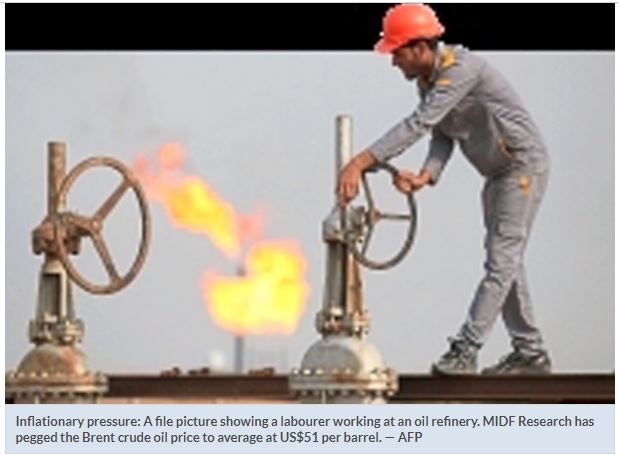Malaysia: Insight – Commodity price inflation a concern
THE rally in commodity prices will likely cause prices especially of food to go up and with the present focus on growth, not much may be done to control this inflation.
Commodity prices, climbing on expectations of normalising demand, can even cause an “explosion in other prices, ” once demand resumes to normal levels.
Will there be a way to control this kind of inflation?
In a low growth environment, central banks which have only monetary policy to stimulate growth, will likely prioritise growth ahead of fighting inflation.
For a small, open economy like Malaysia, raising interest rates may not have much effect against the global demand for commodities.
There is likely to be a greater tolerance of historically high inflation rates, said former Inter-Pacific Securities head of research Pong Teng Siew. (pic below)
For Malaysia, anything above 3.5% is already matching historical highs, while many expect inflation at 1.5% to 2.5% next year, any re-introduction of the goods and services tax will likely push it above 3%.
Inflation is actually a good tool to “inflate away” government debts; so, it may be advantageous to have higher than usual inflation.
A country may borrow heavily now to spend, let inflation run higher and pay back many years later with the devalued purchasing power of its currency.
Inflation reduces purchasing power as the general price level rises, each unit of the currency buys fewer goods and services.
Inflation is usually caused by a rise in demand, which sends prices higher.
The pick-up in prices this time is actually not strong enough to cause over-heating.
While massive fiscal stimulus and rate cuts including putting helicopter money into the pockets of consumers, will revive spending, price levels are likely to remain manageable.
There is spare capacity and it will take some time for unemployment to come down; hence, wage-induced inflation will be moderate, said Socio Economic Research Center executive director Lee Heng Guie.
Asset price inflation is expected in a low interest rate environment but inflation from consumption due to overwhelming demand, is unlikely, said Fortress Capital CEO Thomas Yong. (pic below)
However, this time, the cause of inflation is not so much a pick up in prices; it is the other way round, that is, commodity prices rallying causing prices, especially of food, to rise.
This global rise in commodity prices is so powerful that even the effect of lower demand cannot slow down the overall firming in prices.
In fact, a “compressed and delayed” process of price rises may quickly set off inflationary pressures.
Even now, during a period of recovering demand, prices are not weak; they are climbing without actual increased demand; they are likely to rise even more, on actual increase in demand.
In the past, increases in the price of oil was a major reason for a surge in the price of goods and services.
Oil is a major commodity used in most activities, price increases will lead to higher costs of transport as well as production of plastics, synthetic materials and chemical products.
Currently, the oil futures curve is indicating tighter supply, said Bloomberg, on booming demand from Asia and as the Organisation of Petroleum Exporting Countries plus, agree on gradual output cuts.
Expecting higher global commodity prices next year, MIDF Research has pegged Brent crude oil price to average at US$51 per barrel and crude palm oil at RM2,700 per tonne.
There may be an interest hike of 25 basis points in the fourth quarter next year, said MIDF, adding that the ringgit may appreciate further 4.04 against the US dollar by year end.
As investors rotate out of the technology sector into commodities, further price momentum next year for commodities is anticipated.
Besides price run-ups in agricultural commodities, copper futures are around seven-year highs driven by stronger-than- expected manufacturing activity in China and South Korea.
Optimism over the availability of Covid-19 vaccine, and a weaker US dollar, also played a part in supporting commodity prices.Copper price has surged more than 22% this year, set for its best year since 2017.
The current price strength is only the first leg of a structural bull market in copper, which is used in everything from power to construction, said CNBC, quoting Goldman Sachs.
Unprecedented demand, among other factors, from China for iron ore, the raw material used in steel making, drove prices up 5.8% last Friday from a day earlier.
Prices for benchmark 62% Fe fines imported into northern China, had hit US$145.01 per tonne, representing its highest level since March 2013, over 2020, iron ore prices have gained over 57%, said Mining.com, quoting Fastmarkets MB.
A conflict between China and Australia, its top supplier of iron ore, had also raised iron ore prices.
Commodity price inflation has been a well-trodden path for commodity cycles; we should not be caught by surprise if it happens again.
Yap Leng Kuen is the former business editor of StarBiz. Views expressed here are the writer’s own.
Source: https://www.thestar.com.my/business/business-news/2020/12/07/insight—commodity-price-inflation-a-concern


 Thailand
Thailand






